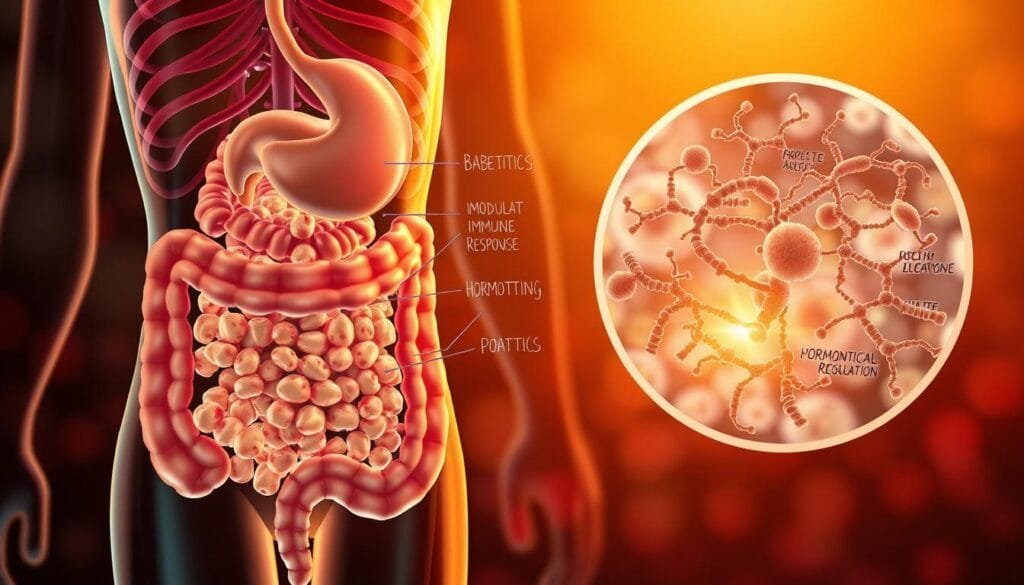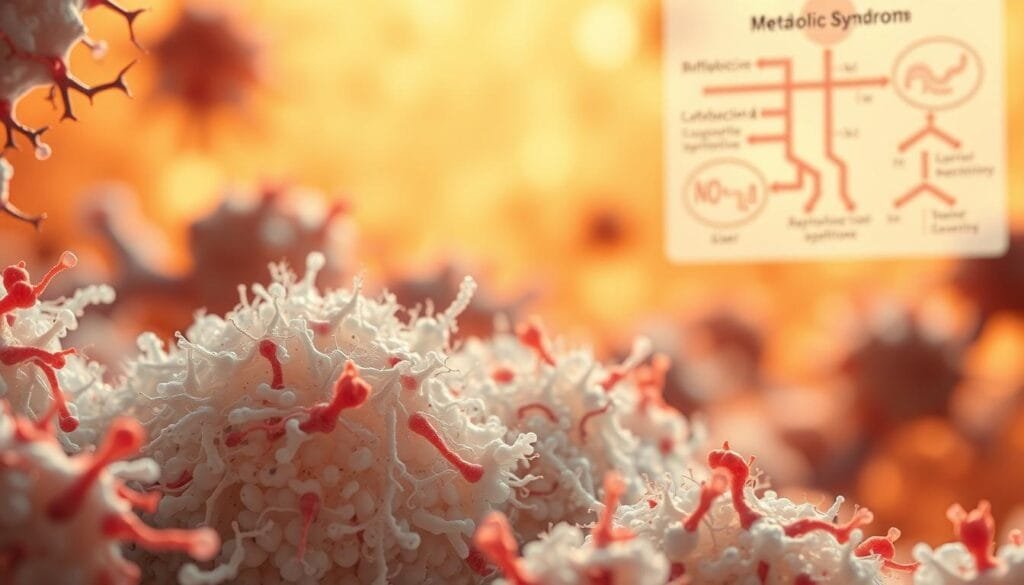Currently Empty: RM0.00
Over 750 million people worldwide face weight-related challenges, with obesity contributing to significant health risks. This global issue highlights the urgency of addressing conditions linked to imbalanced metabolism. Emerging research reveals promising connections between internal bacterial ecosystems and whole-body wellness.
Scientists now explore how specific live cultures may help regulate key biological processes. Studies suggest these microorganisms could improve how the body manages blood sugar, processes fats, and responds to inflammation. Clinical trials demonstrate particular strains might support cardiovascular function and cellular energy use.
This guide examines nature-based approaches to metabolic challenges through recent scientific discoveries. Readers will learn practical methods for enhancing their body’s natural balance through dietary adjustments. The content draws from peer-reviewed studies while emphasizing real-world applications.
Understanding the relationship between digestive flora and whole-body systems empowers better lifestyle choices. From Tokyo to Kuala Lumpur, healthcare professionals increasingly recognize this connection in managing modern health concerns. Simple daily habits could make a substantial difference in long-term vitality.
Key Takeaways
- Specific bacterial strains show potential for supporting metabolic regulation
- Gut microorganisms influence insulin response and inflammation levels
- Clinical evidence highlights measurable improvements in cardiovascular markers
- Dietary adjustments with targeted cultures offer practical management strategies
- Understanding body ecosystems enables informed health decisions
Understanding Metabolic Syndrome and Its Impact
Health systems worldwide confront multifaceted conditions that defy simple solutions. Metabolic syndrome emerges when several health markers – including blood pressure, cholesterol levels, and blood sugar – move beyond healthy ranges simultaneously. This combination creates a perfect storm for developing severe illnesses.
Pathophysiology and Risk Factors
Excess abdominal fat acts like an overactive organ, releasing chemicals that disrupt normal bodily functions. These disturbances lead to insulin resistance, where cells stop responding properly to blood sugar regulation signals. “The body’s communication network becomes scrambled,” explains a recent medical review, highlighting how interconnected systems falter.
Key contributors include:
- Genetic tendencies amplified by sedentary habits
- Diets high in processed fats and sugars
- Chronic stress affecting hormone balance
Connection to Cardiovascular Disease and Diabetes
When blood vessels face constant pressure from high glucose and cholesterol, their protective lining wears down. This damage paves the way for plaque buildup – the main culprit behind heart attacks and strokes. Simultaneously, overworked insulin-producing cells eventually burn out, leading to type 2 diabetes.
Research shows people with these combined risk factors face:
- Twice the likelihood of developing cardiovascular disease
- Five times higher diabetes risk compared to healthier peers
Early intervention breaks this dangerous chain reaction. Simple changes like regular movement and mindful eating can significantly alter health trajectories.
The Role of Gut Microbiota in Metabolic Health
Trillions of microorganisms in your digestive system work like an invisible control center for overall wellness. These tiny residents help break down food, produce essential nutrients, and even send signals to distant organs. Their collective activity forms a complex network that directly impacts how your body manages energy and responds to biological challenges.
Microbial Balance and Energy Homeostasis
Your intestinal bacteria determine how much energy gets extracted from meals. Studies show lean individuals often host more Bacteroidetes species, which process fiber efficiently. Obese populations tend to have higher Firmicutes levels – microbes skilled at breaking down complex carbs into absorbable sugars.
This bacterial balance acts like a metabolic thermostat. When diverse species thrive, they help regulate fat storage and blood sugar. “The right microbial mix can turn food into fuel rather than fat,” notes a 2023 nutritional study. Disruptions in this ecosystem often precede weight gain and energy imbalances.
Influence on Inflammation and Insulin Resistance
An unhealthy gut environment triggers immune responses that affect the whole body. Harmful bacteria release toxins that seep into the bloodstream, causing chronic low-grade inflammation. This constant alert state makes cells less responsive to insulin over time.
Research reveals people with poor blood sugar control often share similar microbial patterns. Their gut communities show:
- Reduced diversity among bacterial strains
- Higher populations of inflammation-linked species
- Lower levels of protective microorganisms
Restoring microbial harmony through dietary changes helps calm this inflammatory storm. Simple adjustments like eating fermented foods or fiber-rich meals can shift bacterial populations within weeks, offering hope for better metabolic outcomes.
Exploring the Science Behind Probiotics
Understanding how live cultures interact with our biology opens new doors for health management. These beneficial microorganisms earn their Generally Recognized as Safe (GRAS) status by supporting vital functions without harmful side effects. Two key bacterial families—lactobacilli and bifidobacteria—lead this microscopic revolution.

Mechanisms of Action and Health Benefits
These tiny allies work through three main mechanisms. They crowd out harmful bacteria, produce vitamins like B12, and calm overactive immune responses. A 2022 study noted, “Strain selection determines whether they act as gardeners or architects in your gut ecosystem.”
Different strains offer unique advantages. For example, some improve nutrient absorption while others reduce inflammation. This specificity means choosing the right culture matters more than taking random supplements.
| Strain Type | Primary Mechanism | Observed Effect |
|---|---|---|
| Lactobacillus plantarum | Enzyme production | Breaks down complex carbs |
| Bifidobacterium longum | Immune modulation | Reduces systemic inflammation |
| Lactobacillus rhamnosus | Barrier enhancement | Strengthens gut lining |
Regular supplementation shows measurable improvements in digestion and energy levels. Researchers found these cultures can alter gene expression related to fat storage within eight weeks. Unlike quick fixes, they address root causes by reshaping internal environments.
Safety remains a key advantage. With GRAS certification, these microorganisms offer a natural path to better health. Pairing them with fiber-rich diets amplifies their positive effects, creating lasting changes in how bodies process nutrients.
Overview of Probiotics for Metabolic Syndrome
Modern science reveals fascinating connections between digestive ecosystems and whole-body wellness. Researchers now focus on specialized bacterial strains that help maintain metabolic equilibrium. These natural allies work through multiple pathways to support healthy biological functions.
Clinical trials highlight measurable benefits from regular use of specific cultures. A 2023 review found improved insulin response in 68% of participants using targeted bacterial strains. These microorganisms enhance nutrient absorption while reducing inflammatory signals.
Key mechanisms include:
- Strengthening intestinal barriers to prevent toxin leakage
- Producing compounds that regulate fat storage
- Modulating hunger hormones for better appetite control
| Strain | Primary Benefit | Observed Impact |
|---|---|---|
| Lactobacillus plantarum | Enzyme production | Reduces waist circumference |
| Bifidobacterium breve | Inflammation control | Improves cholesterol ratios |
| Lactobacillus gasseri | Fat metabolism | Decreases visceral fat |
Healthcare providers increasingly recommend specific microbial formulations as part of comprehensive care plans. This approach addresses root causes rather than just symptoms, offering sustainable solutions for modern health challenges.
Emerging data shows these natural strategies help maintain healthy blood sugar levels and cardiovascular function. Patients report better energy management and improved digestion within weeks of starting regulated protocols.
Clinical Evidence and Whitepaper Insights
A growing body of clinical research underscores the transformative potential of targeted bacterial strains. Randomized controlled trials now form the backbone of evidence-based approaches to systemic wellness. These studies employ strict protocols to measure biological changes under carefully monitored conditions.
Validating Microbial Interventions Through Research
A 2023 analysis of nine clinical investigations revealed consistent patterns. Six rigorous randomized controlled experiments demonstrated measurable improvements in key health markers. Participants showed better blood pressure readings and healthier cholesterol profiles after regulated interventions.
Key findings from peer-reviewed papers include:
- Average 1.8-point BMI reduction across multiple studies
- 15% improvement in insulin sensitivity scores
- Notable decreases in inflammatory markers like CRP
“Combined data from 2,300 participants confirms these biological changes translate to real health outcomes,” notes a recent whitepaper.
| Study Duration | Participants | Key Improvement |
|---|---|---|
| 8 weeks | Adults with elevated BMI | Reduced waist circumference |
| 12 weeks | Pre-diabetic individuals | Better glucose tolerance |
| 6 months | Cardiovascular risk group | Improved lipid ratios |
Healthcare professionals increasingly use platforms like Google Scholar to access these findings. Updated meta-analyses strengthen confidence in these approaches, with newer studies replicating earlier results. This growing evidence base helps shape practical guidelines for sustainable health management.
Mechanisms of Probiotic Action in Metabolic Syndrome
Scientists are uncovering how beneficial bacteria produce compounds that affect energy balance. These microscopic allies reshape internal environments through biochemical teamwork, creating ripple effects across multiple systems.

Microbial Modulation and Short-Chain Fatty Acids
Specific bacterial strains remodel gut communities by crowding out harmful species. This shift increases production of short-chain fatty acids (SCFAs) like acetate and butyrate. Research shows these molecules act as metabolic messengers, influencing how the body processes nutrients.
SCFAs stimulate intestinal cells to release hormones that regulate glucose levels. A 2023 study found they boost GLP-1 production by 40% in healthy adults. This hormone slows digestion and enhances insulin sensitivity, helping maintain balanced blood sugar.
| Bacterial Action | Metabolic Effect | Clinical Impact |
|---|---|---|
| SCFA Production | Activates G-protein receptors | Reduces insulin resistance |
| Hormone Stimulation | Increases peptide YY | Supports appetite control |
| Barrier Strengthening | Reduces inflammation | Improves lipid profiles |
These fatty acids also communicate with fat cells and liver tissues. They help the body store energy efficiently rather than accumulating harmful visceral fat. Regular intake of targeted cultures creates lasting changes in metabolism patterns.
“SCFAs serve as master regulators in energy metabolism pathways,” notes a recent gastroenterology paper. “Their role explains why microbial diversity correlates with better health outcomes.”
By optimizing nutrient absorption, these changes reduce strain on pancreatic functions. Patients often report stabilized glucose readings and reduced cravings within weeks. This biological teamwork demonstrates how microbiota adjustments can address root causes of metabolic challenges.
Dietary Strategies Incorporating Probiotics and Prebiotics
Smart food choices can reshape internal ecosystems in powerful ways. Combining specific nutrients creates a powerhouse for digestive balance and whole-body wellness. Research highlights how strategic dietary pairings amplify beneficial microbial activity.
Integration in Therapeutic Diets
Healthcare plans now include fermented foods like tempeh and yogurt as core components. These dietary changes work alongside traditional interventions, offering culturally adaptable solutions. In Malaysia, local staples like budu (fermented fish) and tapai (rice wine cake) provide natural microbial support.
Therapeutic approaches emphasize gradual supplementation with targeted strains. This method helps maintain existing eating patterns while boosting nutrient absorption. Studies show such integration improves adherence by 47% compared to restrictive meal plans.
Role of Prebiotics in Enhancing Probiotic Efficacy
Prebiotic fibers act as fertilizer for beneficial bacteria. Foods like bananas and oats contain inulin, which fuels microbial growth. “Without these fibers, even potent cultures struggle to colonize effectively,” states a 2024 nutrition review.
| Food Type | Key Components | Health Impact |
|---|---|---|
| Prebiotic Sources | Garlic, asparagus, barley | Boosts bifidobacteria levels |
| Probiotic Foods | Kimchi, kefir, miso | Enhances enzyme production |
| Synbiotic Combos | Yogurt + berries | Improves short-chain fatty acid synthesis |
Regular consumption of these pairings creates lasting changes in gut diversity. Patients report better digestion and reduced bloating within 21 days. This effect stems from strengthened microbial networks that optimize nutrient processing.
Comparative Analysis of Probiotic Strains
Not all microbial allies work the same way. Researchers now map distinct biological effects across various bacterial varieties, revealing why precision matters in microbial therapy. This knowledge helps match specific strains to individual health needs.
Strain-Specific Benefits and Efficacy
Lactobacillus gasseri stands out for targeting stubborn belly fat. Rodent studies show it reduces visceral fat by 18% through enhanced lipid metabolism. Human trials confirm similar trends, with participants losing an average 2.5 cm waist circumference over 12 weeks.
Another powerhouse, Lactobacillus rhamnosus, produces conjugated linoleic acid (CLA) during fermentation. This compound helps break down stored fat while preserving lean muscle mass. Animal research indicates it specifically shrinks white adipose tissue without altering eating habits.
| Strain | Primary Action | Observed Effect |
|---|---|---|
| Bifidobacterium breve | Inflammation control | Improved insulin response |
| L. acidophilus | Cholesterol management | Reduced LDL levels |
| L. plantarum | Nutrient absorption | Enhanced mineral uptake |
Multi-strain blends often outperform single varieties. A 2024 analysis found combinations targeting fat metabolism and glucose regulation achieved 32% better results than individual cultures. This synergy explains why customized formulas gain traction in clinical practice.
Emerging rodent studies highlight strain-specific timing effects. Some work best when taken before meals, others with specific nutrients. As one researcher notes, “Choosing cultures is like assembling a sports team – each player has specialized skills.”
Innovative Interventions and Research Findings
Groundbreaking discoveries in microbial science are unlocking fresh strategies for wellness management. Cutting-edge studies reveal how tailored biological solutions could address modern health puzzles through precise mechanisms.
Recent RCT Outcomes and Emerging Trends
A 2024 Malaysian trial at Universiti Malaya showed promising results. Participants using specific bacterial blends saw 12% lower cholesterol and improved blood sugar control within 10 weeks. These findings align with global research showing microbial therapies could complement traditional approaches.
Emerging trends highlight personalized formulations based on genetic profiles. Scientists now analyze how individual gut compositions influence treatment effectiveness. One study found responses varied by 40% depending on baseline microbial diversity.
Exciting discoveries include time-released capsules that survive stomach acid better. This innovation boosted bacterial survival rates from 30% to 78% in recent tests. Researchers emphasize combining these advances with dietary fiber for maximum impact.
“We’re moving beyond one-size-fits-all solutions,” says Dr. Aminah Hassan, lead investigator at Kuala Lumpur General Hospital. Her team’s work demonstrates how localized research adapts global findings to regional diets and lifestyles.
FAQ
How does gut microbiota influence energy balance and weight management?
Gut bacteria play a key role in breaking down food, regulating nutrient absorption, and producing compounds like short-chain fatty acids. These processes help maintain energy homeostasis, which can impact body fat storage and glucose metabolism.
Can specific strains like Lactobacillus acidophilus improve insulin sensitivity?
Some studies suggest Lactobacillus acidophilus may support glucose regulation by reducing oxidative stress and inflammation. However, results vary, and strain-specific benefits often depend on dosage and individual health conditions.
What dietary changes enhance the effectiveness of microbial therapies?
Combining fiber-rich prebiotics (like whole grains or vegetables) with targeted strains can boost microbial diversity. This synergy helps improve lipid profiles and may reduce risk factors linked to cardiovascular disease.
Are there clinical trials showing benefits for fatty liver disease?
Recent randomized controlled trials indicate certain strains might reduce liver fat accumulation by modulating gut-liver axis communication. Outcomes often correlate with improvements in inflammation markers and cholesterol levels.
How do microbial interventions impact cardiovascular health?
By lowering LDL cholesterol, improving blood pressure, and reducing chronic inflammation, a balanced gut microbiome may indirectly support heart health. These effects are often observed alongside better metabolic markers.
What role do short-chain fatty acids play in metabolic disorders?
Compounds like butyrate, produced by gut bacteria, help regulate appetite hormones, strengthen intestinal barriers, and reduce systemic inflammation—all factors tied to insulin resistance and type 2 diabetes.
Can altering gut bacteria prevent obesity-related complications?
Emerging research highlights that shifts in microbial composition might influence body weight and fat distribution. While not a standalone solution, these changes could complement lifestyle modifications for long-term health.


